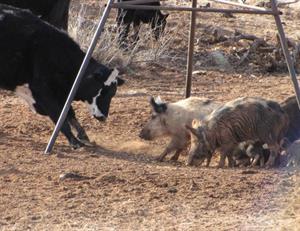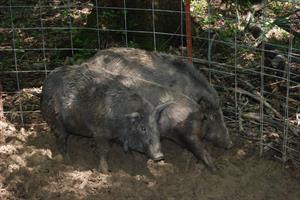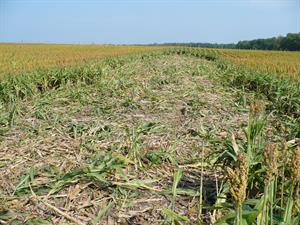It’s just after sunrise in Brownfield, a small farming community in northwest Texas. The area has long been known for peanut production, and farmers in this region produce a sizable portion of the country’s peanut crop.
In recent years, however, peanut farmers have suffered heavy losses. Under the cover of darkness, feral swine are devouring peanuts planted in the ground. The signs of pig destruction are unmistakable: fields bearing heart-shaped pig tracks, the earth upturned every few feet where the swine rooted up peanuts and feasted through the night.
Texan Kyle Lange is on the front lines of efforts to eradicate these invaders. His methods may sound radical — a helicopter and a couple of sharpshooters — but it’s a sign of how serious the feral pig problem is for communities in Texas and the southeastern United States. And there is growing concern that this problem will spread across the nation.
Going Hog Wild
Pigs first arrived on our shores in the 1530s, when Spanish explorers brought domesticated pigs to what is now the southeastern United States. Pigs that escaped adapted quickly to their new habitat. There was plenty of space and food, and native species weren’t prepared to deal with the new competition. Farming practices allowed domesticated pigs to roam freely, which sped their spread.
In the early 1900s, Eurasian wild boars (identifiable by their tell-tale hair) were imported and released into American “hunting preserves.” Many of these boars quickly made a break for freedom and bred with domesticated pigs that had become feral. Wild pigs today include various combinations of these two breeds.
However, the real explosion of wild pig populations has happened in just the past 25 years — the result of what Dr. Billy Higginbotham, professor and extension wildlife and fisheries specialist at Texas A&M, calls the “perfect storm” for pigs. First, landowners and sportsmen have moved wild pigs into new territories — landowners bringing in domestic pigs as livestock (and losing some of them to the wild) and sportsmen moving in feral pigs for hunting. Second, food plots for other wildlife (deer, turkey, quail) supplement the diets of wild pigs, supporting larger pig populations. Finally, wild pigs are prolific breeders. Sows reach sexual maturity at six months and can produce up to 20 offspring a year — especially when well fed.
Wild pigs are highly adaptable and intelligent. Paved roads have made it easier for pigs to reach new areas. The animals have grown accustomed to living in close proximity to human pop-ulations, where pigs feed on refuse; root up lawns, gardens, and golf courses; and stay largely out of sight as they spend their days in areas of thick cover and feed only at night. They also learn from unsuccessful efforts to capture or kill them.
In 1982, only 16 states had wild pig populations, primarily in the southern half of the country. Today, wild pigs are found in 39 states, including as far north as Wisconsin and New York. (See the map on page 44 for details.) Oregon Department of Fish and Wildlife officials estimated their pig population at 2,000 to 5,000 animals in 2012. In Michigan, feral swine were spotted in 72 out of 83 counties, and the Department of Natural Resources estimated the population at 1,000 to 3,000 animals in 2011. These numbers are far below the 1.5 million wild pigs found in Texas — and wildlife agencies in northern states are working to keep it that way. The total U.S. population of wild pigs is estimated at 4 to 8 million today.
The Problem with Pigs
Across the country, feral swine cause an estimated $1.5 billion in damage each year, primarily by feeding on crops, trampling crops, and rooting through soil. Researchers at Auburn University surveyed farmers to break down pig damage in 2009. Of Alabama’s estimated $75 million in crop damage caused by wild pigs, almost $50 million was to corn crops, more than $10 million to peanut crops, and additional damage was done to cotton, soybean, hay, and wheat crops. In addition, more than half a million acres of forest land were damaged by wild pigs. Roads, pastures, food plots, and livestock fencing also suffered significant damage.
 Wild pigs cause problems for native plants and wildlife. As pigs move in, they out-compete native species in a relatively short period of time, leaving resources (both natural and agricultural) depleted. In Texas, for example, feral swine compete with deer and turkey for oak mast (acorns), which can make up 50 percent of deer and turkey diets in the fall. Wild pigs have a competitive advantage because they use their sense of smell to find acorns rather than relying on eyesight. Pigs are more likely to completely deplete an area of mast, eliminating future food sources as well since there are no seeds left to grow new trees. This in turn allows invasive non-native plants to establish themselves in the area. Wallowing and travel along waterways promotes soil erosion and bacterial contamination, which can damage native aquatic plants and animals.
Wild pigs cause problems for native plants and wildlife. As pigs move in, they out-compete native species in a relatively short period of time, leaving resources (both natural and agricultural) depleted. In Texas, for example, feral swine compete with deer and turkey for oak mast (acorns), which can make up 50 percent of deer and turkey diets in the fall. Wild pigs have a competitive advantage because they use their sense of smell to find acorns rather than relying on eyesight. Pigs are more likely to completely deplete an area of mast, eliminating future food sources as well since there are no seeds left to grow new trees. This in turn allows invasive non-native plants to establish themselves in the area. Wallowing and travel along waterways promotes soil erosion and bacterial contamination, which can damage native aquatic plants and animals.
A localized drop in available resources can cause die-offs of native game populations. For example, in west Texas, Kyle Lange witnessed a decline in mule deer and pronghorn antelope populations as pig numbers increased. Fortunately, as hog eradication efforts have increased, he has seen a rebound in both deer and pronghorn populations. In fact, we saw several large herds of mule deer, many of which included old bucks — something Lange said was uncommon just a few years ago. Wild pigs also take a significant toll on ground-nesting bird species such as waterfowl and turkeys because they raid nests and kill hatchlings.
Wild hogs pose a major risk to animals and humans as vectors of disease. They can carry and spread at least 30 deadly illnesses, including foot-and-mouth disease and pseudorabies. They are reservoirs for bovine tuberculosis, a bacterial infection that is fatal to cattle, and carry diseases that can devastate domestic pig stocks. Wild pigs also carry 37 known parasites that can affect pets, livestock, and even humans. According to the Centers for Disease Control and Prevention, hunters have contracted Brucella suis — a bacterial infection also known as swine brucellosis — after field dressing wild pigs. Previously, this flu-like illness was found only in slaughterhouse workers. Wild pigs have even caused levels of fecal coliform to exceed human health standards in some streams, according to the U.S. Department of Agriculture (USDA). Feral swine carrying the E. coli bacteria were identified as the possible culprits in a case of contaminated California spinach that resulted in several deaths.
To reduce the dangers to people and wildlife, scientists and communities are looking at different ways to solve the wild pig problem.
Controlling Pig Populations
Pilot Kyle Lange drives down a dusty Texas road to a vineyard tucked away from the traffic on Route 86. At the vineyard, Lange pumps diesel fuel from his Chevrolet pickup truck into a small, four-seat helicopter while four sharpshooters load magazines for their rifles. On this morning, the landscape is still and the wind is calm, a rarity for the area. It’s a perfect day to fly. The morning silence is broken as the helicopter rotors begin to turn and the sandy soil shifts under the sudden rush of air. Two of the men with rifles climb into the chopper, one in the front, one in the back, and put on their headphones. Then the chopper’s motor revs and the machine rises into the sky. Lange turns west, moving toward a shallow lake on the horizon surrounded by salt cedars. That’s where the pigs will be, Lange suspects. With any luck, they’ll find one or two sounders (family groups), maybe even more, and if the shooters can take out a few dozen local pigs that morning, then perhaps the next peanut crop will survive one more night.
Across the state, just outside Houston’s ever-expanding urban sprawl, USDA researchers are working to capture wild hogs in a corral trap to examine their teeth. Hog damage to crops in this area, as in Brownfield, has been extensive. Researchers previously put out corn-pile baits treated with tetracycline hydrochloride, which leaves a fluorescent mark on the hogs’ teeth and bones after the chemical is ingested. The goal now is to capture wild hogs feeding in these fields and examine their teeth for signs of the fluorescent marker, which gives scientists an idea about the overall population. In areas where the same wild hogs are repeatedly captured, the total population is likely to be low. In areas where hogs with marked teeth rarely show up twice, it’s a good indication that more pigs overall live in that area. This examination shows what many people have known for some time: the area is home to a very large and growing population of destructive feral swine.
More than a thousand miles away, Jonathan McKnight, associate director of the Natural Heritage Program at Maryland’s Department of Natural Resources, is trying to prevent his state from becoming overrun with feral hogs. Maryland is in a unique position — a state that has remained relatively hog-free while being surrounded by pigs. For McKnight, monitoring for hogs that come into the state from surrounding areas is important, and he is notified when pigs are hit on highways, which has happened along the border with Pennsylvania. McKnight knows that helicopter hunting won’t work well in the highly urbanized and wooded landscapes of Maryland, so he has to think about other means to prevent a feral swine outbreak. One of his most critical jobs is ensuring feral hog problems don’t become a homegrown problem. He monitors pig farmers to ensure they are keeping their stock properly secured and aren’t letting them roam free — the transformation from domestic pig to a feral one could take only a generation or two. For Maryland hunters, McKnight’s directive is simple: shoot wild pigs on sight.
Other methods of control include baiting and trapping pigs. According to Higginbotham, trapping is one of the best practices for hog removal, especially in areas where helicopters can’t be flown.
Sights Set on Swine
 It’s just after nine in the morning and I’m a hundred feet above the bare peanut fields outside Brownfield, Texas. Kyle Lange is at the helm of his helicopter, the Raven II, and we’re heading out in search of a sounder of pigs that has been wreaking havoc on agricultural fields and destroying watering sites used by domestic livestock and wildlife. It isn’t hard to spot the signs of recent pig activity: the edges of the water sites are muddied and sloppy, and hard-packed trails covered with fresh pig prints radiate out from the water like the spokes of a wheel. This isn’t a hunting trip, it’s an eradication mission, and Lange spends much of his time crisscrossing the skies over fields that have been subscribed to this pig reduction program.
It’s just after nine in the morning and I’m a hundred feet above the bare peanut fields outside Brownfield, Texas. Kyle Lange is at the helm of his helicopter, the Raven II, and we’re heading out in search of a sounder of pigs that has been wreaking havoc on agricultural fields and destroying watering sites used by domestic livestock and wildlife. It isn’t hard to spot the signs of recent pig activity: the edges of the water sites are muddied and sloppy, and hard-packed trails covered with fresh pig prints radiate out from the water like the spokes of a wheel. This isn’t a hunting trip, it’s an eradication mission, and Lange spends much of his time crisscrossing the skies over fields that have been subscribed to this pig reduction program.
Lange knows where pigs usually hole up, and he’s put us in the right position. A grown boar emerges from the salt cedar, and we move down for a shot. As the boar begins a long run across the open ground, Lange positions the helicopter parallel to the pig so I have a shot. The rifle claps once, sending a spray above the pig’s back. The second shot sends the pig nose-first into the dry earth, dead before it hits the ground.
Currently, Texas is the capital of heli-hogging. Shooting pigs from the air is efficient and costs as little as $20 per pig, says Higginbotham. Ninety percent of eradication efforts in Texas involve helicopters (although fixed-wing aircraft are legal too). California and New Mexico are also using helicopters to control wild pigs in some areas. New York, which has only recently become a haven for hogs, is using helicopters to study pig populations and, in some cases, shoot pigs.
Hunting hogs on the ground is one of the least expensive hunts available, and many states have very liberal seasons, bag limits, and restrictions. When properly prepared, wild hog meat is also a good source of healthy — and delicious — protein. Abel Vega, a member of the League’s Bethesda-Chevy Chase Chapter in Maryland, enjoys pig hunting in Georgia. On his last hunt, he took two 80-pound pigs and his wife took a large 150-pound hog. For Vega, this is a challenging form of hunting that is affordable and highly accessible.
Recreational hunting by itself is not a solution to controlling wild pig populations. “In Texas, we need to reduce our pig populations by 66 percent just to keep them stable,” says Higginbotham. “Last year, we reduced the population 29 percent, and only 11 percent of that reduction came from recreational hunting.” However, sportsmen and other people who enjoy the outdoors can make a valuable contribution to feral swine eradication efforts.
What You Can Do
 One of the most significant ways in which people can help control wild pig populations is to learn the signs, including rooting, wallowing, and trampling vegetation as the hogs feed and move. Most of this damage is done at night, as these hogs are primarily nocturnal (especially in areas where they receive pressure from hunters), so learning to recognize the damage and signs left behind is a critical first step in controlling local pig populations.
One of the most significant ways in which people can help control wild pig populations is to learn the signs, including rooting, wallowing, and trampling vegetation as the hogs feed and move. Most of this damage is done at night, as these hogs are primarily nocturnal (especially in areas where they receive pressure from hunters), so learning to recognize the damage and signs left behind is a critical first step in controlling local pig populations.
In addition to signs of feeding and movement, look for droppings and tracks, which resemble the footprints of deer but tend to be more splayed (spread out) and elongated. Any time you find a wild pig or signs of pigs, notify local wildlife agencies and USDA’s Animal and Plant Health Inspection Service (APHIS). It is illegal to move wild hogs for the purpose of hunting unless the pigs are being moved to a licensed hunting facility. If you see any signs of hunters illegally moving and releasing wild pigs, it is important to report this activity immediately.
Baiting deer and other game with corn, which is legal in some states, may draw pigs into an area and create a situation in which wild swine can spread disease to local wildlife populations. Pigs are also attracted to bird feeders, gardens, and landscaping in residential areas. Keep pigs away by placing mechanical or electric barriers around feeders, and remove any backyard feeders that are attracting hogs.
Resourceful and adaptable, wild pigs are able to survive in almost every climate and landscape in North America. This presents a very real problem for our wildlife and our native habitat, and we need to rally together and do our part to help control these harmful animals.
For more information about wild swine, visit USDA’s Animal and Plant Health Inspection Service’s Web site.